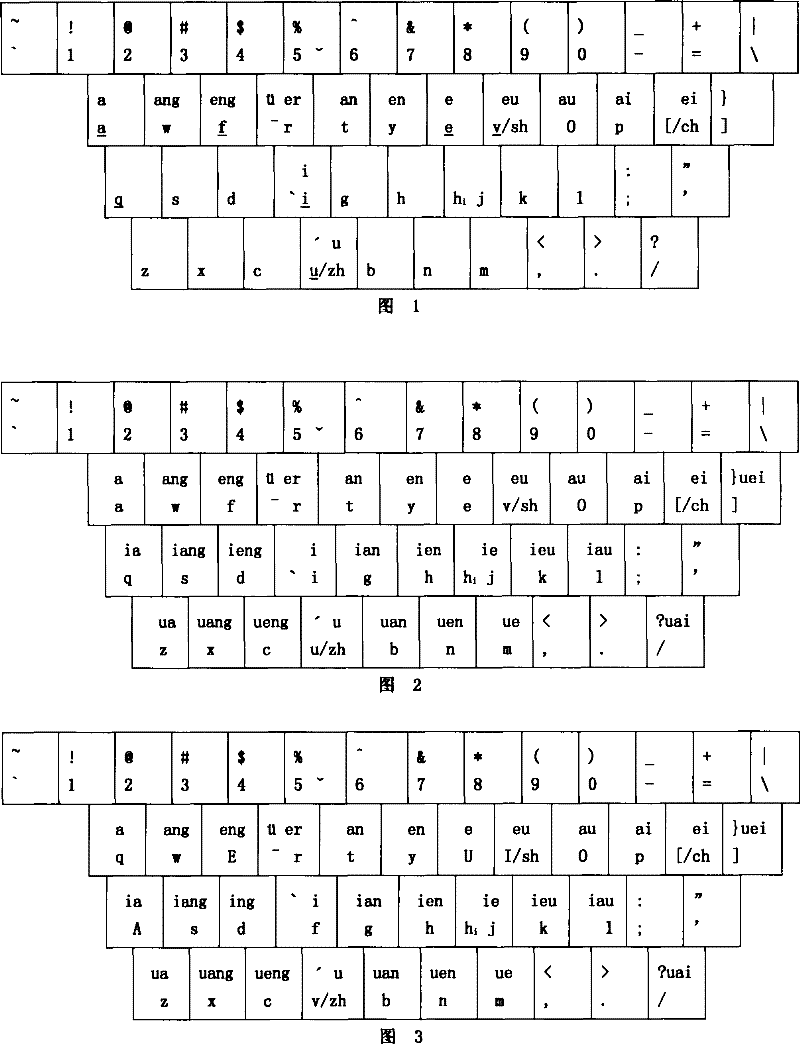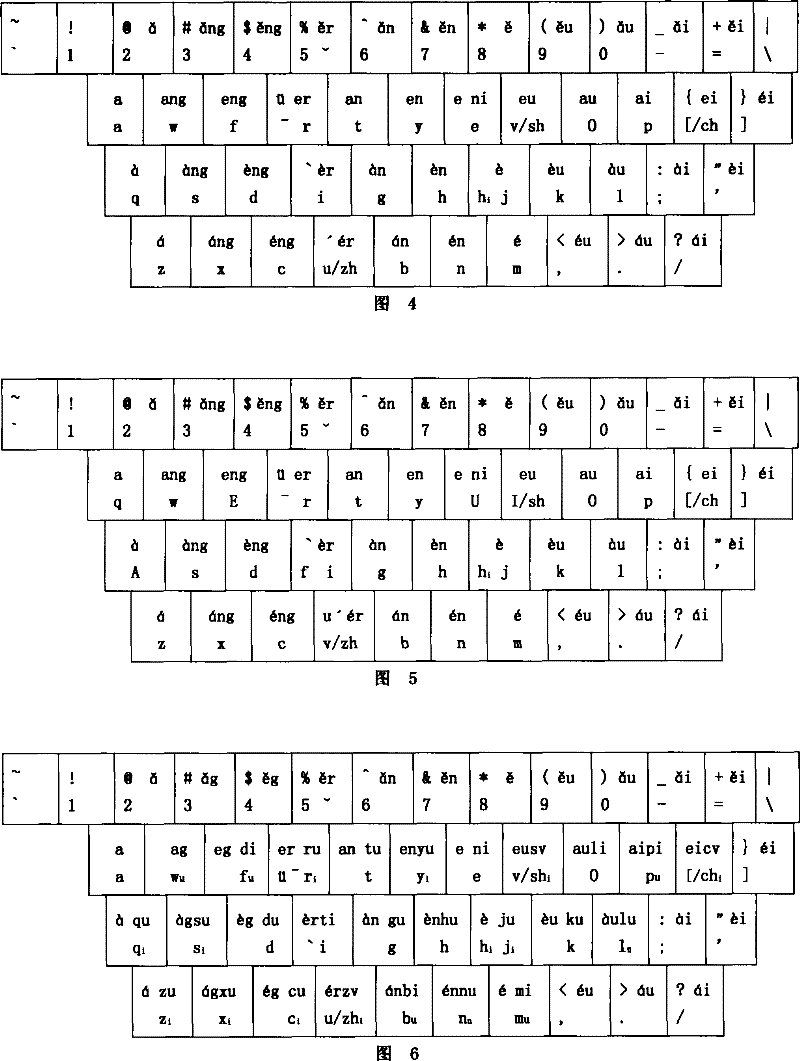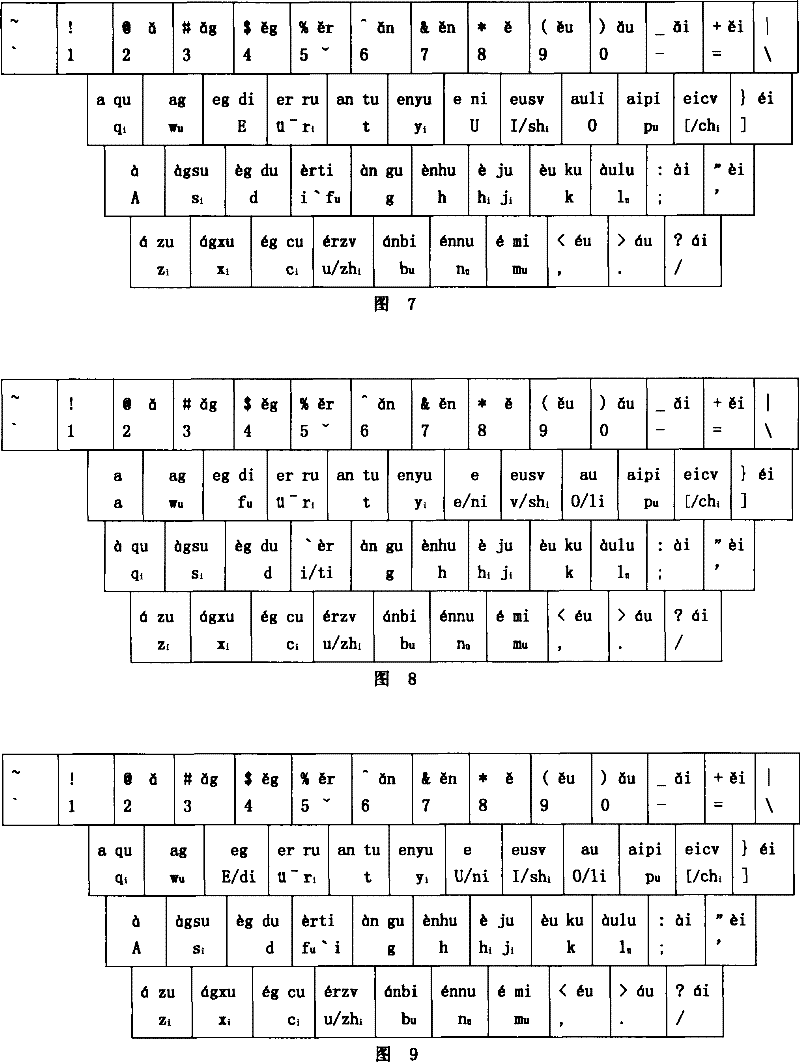Information input method based on Chinese phonetic alphabets
An information input, Chinese technology, applied in the field of electronic computer information processing, can solve the problems of lack of input methods, unreasonable key layout, difficult internationalization, etc., to achieve the effect of facilitating popularization and application
- Summary
- Abstract
- Description
- Claims
- Application Information
AI Technical Summary
Problems solved by technology
Method used
Image
Examples
Embodiment 4
[0093] After the Chinese phonetic coded characters and the key layout are determined, it is necessary to determine the input method. The same key layout also has different input methods for Chinese and / or English or other Latin letters. The single-character input method is relatively simple, but the combined character input method is more complicated: what is the target character to input? What is the maximum input code length? What does each keystroke mean? How to prompt? How to confirm the current input? How to choose repeated code characters? These problems are summarized by the term "input mode" in the present invention, and each input mode has a definite answer. For each key layout, there are several input modes to choose from. For example, on a QWERTY keyboard, after the "Caps Lock" key is pressed, the input mode of lowercase English letters changes to the input mode of uppercase English letters; you can directly use the QWERTY keyboard to input Chinese information...
Embodiment 1
[0094] Embodiment 1: Chinese phonetic alphabet and its key position layout and information input method
[0095] The Chinese phonetic alphabet is assigned on the 4×11 key array, monophonic consonant, extended consonant h i The double initial consonant and its combination are collectively referred to as "full initial consonant". For the alphabet keyboard, the single initial consonant and the English letter with the same font share the key position; the extended intermediary h i or the double initials of its combination are randomly assigned to the key position, or h is omitted according to the southern sound i : designate zh=z, ch=c, sh=s, or be understood as double initials zh, ch, sh are designated on the keys of letters Z, C, and S in turn; it is called "full initials" key layout;
[0096] The syllable is omitted, or assigned to the key position arbitrarily; the tail syllable is assigned to the key position of any column; the single final is specified to be on the 11 keys o...
Embodiment 2
[0102] Embodiment 2: " sound-intermediate rhyme key position layout and information input method thereof
[0103] The combination of jiemu and final is jiefu, which happens to be similar to but different from the final in "Chinese Pinyin Scheme". In order to avoid confusion, we use the concept of intermediate vowels uniformly. Then, except for the tail jiemu, the finals do not include the jiemu.
[0104] The combination of intermediary consonant and single final consonant is intermediary final consonant: ia, ua, uai, ian, uan, üan, iang, uang, iau or iao, ie, ue or uo, üe, uei or ui, ien or in, uen or un, üen or ün, ieng or ing, ueng or ong, üeng or iong, ieu or iou or iu, are called the coded character set of intermediate and final vowels, and combined with the coded character set of Chinese phonetic alphabets, it is called the encoding of Chinese initials and final vowels character set;
[0105] The "intermediate+rhyme+tune" key layout, according to the principle of "inte...
PUM
 Login to View More
Login to View More Abstract
Description
Claims
Application Information
 Login to View More
Login to View More - R&D
- Intellectual Property
- Life Sciences
- Materials
- Tech Scout
- Unparalleled Data Quality
- Higher Quality Content
- 60% Fewer Hallucinations
Browse by: Latest US Patents, China's latest patents, Technical Efficacy Thesaurus, Application Domain, Technology Topic, Popular Technical Reports.
© 2025 PatSnap. All rights reserved.Legal|Privacy policy|Modern Slavery Act Transparency Statement|Sitemap|About US| Contact US: help@patsnap.com



